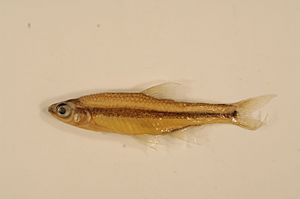Ironcolor shiner facts for kids
Quick facts for kids Ironcolor shiner |
|
|---|---|
 |
|
| Conservation status | |
| Scientific classification | |
| Synonyms | |
|
Hybopsis chalybaeus Cope, 1867 |
The ironcolor shiner (Notropis chalybaeus) is a small, shiny freshwater fish. It belongs to the minnow and carp family, called Cyprinidae. This fish is found in many streams and rivers across eastern North America.
Contents
What Does an Ironcolor Shiner Look Like?
The ironcolor shiner is a small fish, usually about 4.5 to 6.5 centimeters (1.8 to 2.6 inches) long. Its back and sides are yellowish. It has a clear black stripe running along its side, from its tail to its nose. You might also see some dark spots on its chin and lips.
This fish has a short snout, which is shorter than the width of its eye. Its mouth is small and has a black roof. When it's time to breed, male ironcolor shiners become very colorful! They get a bright orange stripe just above their black side stripe. They often have orange spots above and below the black spot on their tail fin too.
Their other fins are usually clear, without much color. But breeding males might show some orange on their fins and body. Males also grow tiny bumps, called tubercles, around their mouth, snout, and on their front fins. The area under their belly, from their chest to their front fins, has no scales. They have a special line on their side, called a lateral line, with 31 to 36 round scales.
Where Do Ironcolor Shiners Live?
Ironcolor shiners live only in the eastern United States. You can find them from New York down to Florida, and west to the Mississippi River. There are also some groups of them in other places. These include the San Marcos River in Texas, and parts of the Illinois River in Illinois and Indiana. They are also in the Cedar River in Iowa, and the Wisconsin River and Lake Winnebago area in Wisconsin. You can also find them in the Lake Michigan area of southern Michigan and northern Indiana.
Sadly, they have disappeared from Iowa. People once thought they were gone from Pennsylvania too. But there is still one group left in Marshalls Creek, Pennsylvania. In South Carolina, they are common but spread out. In New York, the only known group lives in the Bashakill wetlands near Port Jervis.
What Kind of Home Do They Like?
Ironcolor shiners prefer clear, slow-moving creeks and small rivers. These places usually have sandy bottoms and lots of plants growing underwater. They can also live in swamps with soft ground, like in Illinois.
They like to hide among plants such as bladderwort, pondweed, and Elodea. Having sand nearby seems important for them to lay their eggs. They usually don't live in streams fed by groundwater. However, there's a special group in the San Marcos River basin in Texas. These fish live in the upper parts of the river, which are fed by springs.
What About Their Life Cycle?
In the northern parts of their home, ironcolor shiners lay eggs from mid-April to July. In Florida, they might start as late as September. The male fish chase the females in calm water. The females then release their eggs, which scatter over the sand and sink into it.
The eggs hatch after about two days. The young fish grow up quickly and can have their own babies when they are one year old. Ironcolor shiners swim together in medium-sized groups, called schools. These schools often have fish of different ages. They swim in open water and eat small invertebrates.
Their diet includes tiny water creatures like crustaceans (such as amphipods, cladocerans, and ostracods). They also eat water insects like caddisfly larvae, midge larvae, and mayfly larvae. Sometimes they eat corixids (water boatmen) and ants. They might also eat stringy algae, but they don't seem to digest it.
Are Ironcolor Shiners Safe?
The ironcolor shiner lives in a large area across the eastern and central United States. However, in the western parts of their range, many groups are separated from each other. These groups have been shrinking or disappearing. This is often because of dirt and mud in the streams, or water pollution.
They have also declined in the northern parts of their range. But the group in New York's Bashakill wetlands is currently doing well.
See also
 In Spanish: Notropis chalybaeus para niños
In Spanish: Notropis chalybaeus para niños


